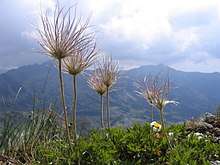Pulsatilla alpina
Pulsatilla alpina (alpine pasqueflower or alpine anemone) is a species of flowering plant in the family Ranunculaceae, native to the mountain ranges of central and southern Europe, from central Spain to Croatia. It is an herbaceous perennial growing to 15–30 cm (6–12 in) tall by 20 cm (8 in) wide, and can be found at altitudes of 1,200–2,700 m (3,900–8,900 ft).
| Pulsatilla alpina | |
|---|---|
| Pulsatilla alpina subsp. alpina | |
 | |
| Fruiting plants of P. alpina subsp. alba | |
| Scientific classification | |
| Kingdom: | |
| (unranked): | |
| (unranked): | |
| Order: | |
| Family: | |
| Genus: | |
| Species: | P. alpina |
| Binomial name | |
| Pulsatilla alpina (L.) Delarbre | |
| Subspecies | |
| |
Characteristics
Pulsatilla alpina has deeply divided, hairy leaves. It has more upright flowers than other species of Pulsatilla, which generally have drooping flowers. They are white or, in the case of subsp. apiifolia, yellow. The flowers are produced very early, often opening while still under snow cover. They have prominent yellow stamens. As with all pasqueflowers, the flowers have a silky, hairy texture, and are followed by prominent seedheads which persist on the plant for many weeks.[1]
Subspecies
A number of subspecies are recognised, based largely on the form and hairiness of the leaves. P. alpina subsp. schneebergensis is endemic to the easternmost Alps of Austria, and is named after the Schneeberg mountain. It is replaced further west by the widespread taxon P. alpina subsp. alpina. P. alpina subsp. austroalpina is found in the Southern Alps from Switzerland eastwards, most commonly over dolomite. P. alpina subsp. apiifolia and P. alpina subsp. alba grow over siliceous rock, but are easily distinguished by the flower colour. Further subspecies have been named for local variants in the Cantabrian Mountains (subsp. cantabrica) and Corsica (subsp. cyrnea).
Cultivation
P. alpina is suitable for cultivation in an alpine garden, or in any sharply drained soil in full sun. It is extremely hardy but dislikes winter wet. The subspecies P. alpina subsp. apiifolia has gained the Royal Horticultural Society's Award of Garden Merit.[2]
See also
References
- RHS A-Z encyclopedia of garden plants. United Kingdom: Dorling Kindersley. 2008. p. 1136. ISBN 1405332964.
- "RHS Plant Selector - Pulsatilla alpina subsp. 'apiifolia'". Retrieved 27 June 2013.
- "Pulsatilla". Integrated Taxonomic Information System.
- Anemone pulsatilla, Wildflowers index, Department of Horticultural Science of NC State University
- Edible and Medicinal plants of the West, Gregory L. Tilford, ISBN 0-87842-359-1
External links
| Wikimedia Commons has media related to Pulsatilla alpina. |
| Wikispecies has information related to Pulsatilla alpina |